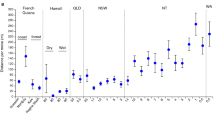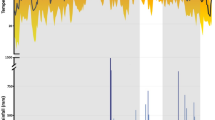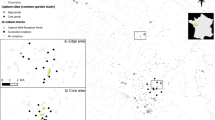Abstract
Evolutionary theory predicts that individuals at an expanding range edge will disperse faster than conspecifics in long-colonized locations, but direct evidence is rare. Previous reports of high rates of dispersal of cane toads (Rhinella marina) at the invasion front have been based on studies at a single site in the Northern Territory. To replicate the earlier work, we radio-tracked free-ranging toads in the Kimberley region of northwestern Australia (at the westward-spreading invasion front) and 500 km northeast, on the Adelaide River floodplain of the Northern Territory (where toads had already been present for 6 years). For comparison, we also radio-tracked native frogs (Litoria caerulea and L. splendida) at the same sites. Consistent with the earlier reports, invasion-front cane toads travelled further per day, were more highly directional, and re-used refuge sites less frequently, than did conspecifics from an already-colonized site. In contrast, native frogs showed similar movement patterns in the two study areas. Our results confirm previous reports, and suggest that accelerated dispersal may be a common feature of individuals at the vanguard of a biological invasion.





Similar content being viewed by others
References
Alford RA, Brown GP, Schwarzkopf L, Phillips B, Shine R (2009) Comparisons through time and space suggest rapid evolution of dispersal behaviour in an invasive species. Wildl Res 36:23–28
Bitton PP, Graham BA (2015) Change in wing morphology of the European starling during and after colonization of North America. J Zool 295:254–260
BOM – Bureau of Meteorology (2016) Climate data online. http://bom.gov.au. Accessed June 2016
Brown GP, Phillips BL, Webb JK, Shine R (2006) Toad on the road: use of roads as dispersal corridors by cane toads (Bufo marinus) at an invasion front in tropical Australia. Biol Conserv 133:88–94
Brown GP, Shilton CM, Phillips BL, Shine R (2007) Invasion, stress, and spinal arthritis in cane toads. Proc Natl Acad Sci USA 104:17698–17700
Brown G, Kelehear C, Shine R (2013) The early toad gets the worm: cane toads at an invasion front benefit from higher prey availability. J Anim Ecol 82:854–862
Brown GP, Phillips BL, Shine R (2014) The straight and narrow path: the evolution of straight-line dispersal at a cane-toad invasion front. Proc R Soc B 281:20141385
Brown GP, Phillips BL, Dubey S, Shine R (2015a) Invader immunology: invasion history alters immune-system function in cane toads (Rhinella marina) in tropical Australia. Ecol Lett 18:57–65
Brown GP, Phillips BL, Shine R (2015b) Directional dispersal has not evolved during the cane toad invasion. Funct Ecol 29:830–838
Brown GP, Kelehear C, Pizzatto L, Shine R (2016) The impact of lungworm parasites on rates of dispersal of their anuran host, the invasive cane toad. Biol Invasions 18:103–114
Chan M, Shine R, Brown GP, Kim PS (2015) Mathematical modelling of spatial sorting and evolution in a host-parasite system. J Theor Biol 380:530–541
Chuang A, Peterson CR (2015) Expanding population edges: theories, traits, and trade-offs. Glob Change Biol 22:494–512
Cowie ID, Short PS, Osterkamp Madsen M (2000) Floodplain flora: a flora of the coastal floodplains of the Northern Territory, Australia. Flora of Australia Supplementary Series Number 10. Australian Biological Resources Study and the Parks and Wildlife Commission of the Northern Territory, Australia
Endler JA (2015) Writing scientific papers, with special reference to evolutionary ecology. Evol Ecol 29:465–478
Forsman A, Merilä J, Ebenhard T (2011) Phenotypic evolution of dispersal-enhancing traits in insular voles. Proc R Soc B 278:225–232
Hudson CH, Phillips BL, Brown GP, Shine R (2015) Virgins in the vanguard: low reproductive frequency in invasion-front cane toads. Biol J Linn Soc 116:743–747
Hudson CM, McCurry MR, Lundgren P, McHenry CR, Shine R (2016a) Constructing an invasion machine: the rapid evolution of a dispersal-enhancing phenotype during the cane toad invasion of Australia. PLoS ONE 11:e0156950
Hudson CM, Brown GP, Shine R (2016b) Athletic anurans: the impact of morphology, ecology and evolution on climbing ability in invasive cane toads. Biol J Linn Soc 119:992–999. doi:10.1111/bij.12827
Kubisch A, Fronhofer EA, Poethke HJ, Hovestadt T (2013) Kin competition as a major driving force for invasions. Am Nat 181:700–706
Lemoine NP, Hoffman A, Felton AJ, Baur L, Chaves F, Gray J, Yu Q, Smith MD (2016) Underappreciated problems of low replication in ecological field studies. Ecology 97:2554–2561
Lindström T, Brown GP, Sisson SA, Phillips BL, Shine R (2013) Rapid shifts in dispersal behavior on an expanding range edge. Proc Natl Acad Sci USA 110:13452–13456
Llewellyn D, Thompson MB, Phillips BL, Brown GP, Shine R (2012) Reduced investment in immune function in invasion-front populations of the cane toad (Rhinella marina) in Australia. Biol Invasions 14:999–1008
Nakagawa S, Parker TH (2015) Replicating research in ecology and evolution: feasibility, incentives, and the cost-benefit conundrum. BMC Biol 13:88
Petheram R, Kok B, Barlett-Torr E (2003) Plants of the Kimberley region of Western Australia. University of Western Australia Press, Crowley
Pettit LJ, Greenlees MJ, Shine R (2016) Is the enhanced dispersal rate seen at invasion fronts a behaviourally plastic response to encountering novel ecological conditions? Biol Lett 12:20160539
Phillips BL (2009) The evolution of growth rates on an expanding range edge. Biol Lett 5:802–804
Phillips BL, Brown GP, Webb J, Shine R (2006) Invasion and the evolution of speed in toads. Nature 439:803
Phillips BL, Brown GP, Shine R (2010a) Life-history evolution in range-shifting populations. Ecology 91:1617–1627
Phillips BL, Brown GP, Shine R (2010b) Evolutionarily accelerated invasions: the rate of dispersal evolves upwards during the range advance of cane toads. J Evol Biol 23:2595–2601
Phillips BL, Kelehear C, Pizzatto L, Brown GP, Barton D, Shine R (2010c) Parasites and pathogens lag behind their host during periods of host range-advance. Ecology 91:872–881
Pinheiro J, Bates D (2000) Mixed-effects models in S and S-Plus. Springer, New York
R Development Core Team (2015) R: a language and environment for statistical computing. Version 3.2.2. The R Foundation for Statistical Computing, Vienna, Austria
Rollins LA, Richardson MF, Shine R (2015) A genetic perspective on rapid evolution in cane toads. Mol Ecol 24:2264–2276
Schwarzkopf L, Alford RA (1996) Desiccation and shelter-site use in a tropical amphibian: comparing toads with physical models. Funct Ecol 10:193–200
Schwarzkopf L, Alford RA (2002) Nomadic movement in tropical toads. Oikos 96:492–506
Shine R, Brown GP, Phillips BL (2011) An evolutionary process that assembles phenotypes through space rather than time. Proc Natl Acad Sci USA 108:5708–5711
Simmons AD, Thomas CD (2004) Changes in dispersal during species’ range expansions. Am Nat 164:378–395
Speare R, Berger L, Skerratt LF, Alford RA, Mendez D, Cashins S, Kenyon N, Hauselberger K, Rowley J (2004) Hygiene protocol for handling amphibians in field studies. http://www.jcu.edu.au/school/phtm/PHTM/frogs/field-hygiene.doc. 8 Oct 2004
Tingley R, Shine R (2011) Desiccation risk drives the spatial ecology of an invasive anuran (Rhinella marina) in the Australian semi-desert. PLoS ONE 6:e25979
Travis JMJ, Dytham C (2002) Dispersal evolution during invasions. Evol Ecol Res 4:1119–1129
Tyler MJ, Knight F (2009) Field guide to the frogs of Australia. CSIRO Publishing, Collingwood
Urban M, Phillips BL, Skelly DK, Shine R (2007) The cane toad’s (Chaunus marinus) increasing ability to invade Australia is revealed by a dynamically updated range model. Proc R Soc B 274:1413–1419
Ward-Fear G, Greenlees MJ, Shine R (2016) Toads on lava: spatial ecology and habitat use of invasive cane toads (Rhinella marina) in Hawai’i. PLoS ONE 11:e0151700
Zar J (2010) Biostatistical analysis, 5th edn. Prentice Hall, Upper Saddle River
Zuur A, Ieno E, Walker N, Saveliev A, Smith G (2009) Mixed effects models and extensions in ecology with R. Springer, New York
Acknowledgements
We thank Bill Stewart, Corrin Everitt, Samantha Price-Rees, Ruchira Somaweera, Jai Thomas, Charlie Sharpe, Samantha Maindok, Greg Smith, David Williams, and Narelle Brook for logistical support in Western Australia, and Michael Crossland in the Northern Territory. All procedures were approved by the University of Sydney Animal Ethics Committee (Protocol L04/5-2010/2/5334) and conducted under permits from Northern Territory and Western Australia Parks and Wildlife (39857 and SF007610, respectively).
Funding
This study was funded by the Australian Research Council (DP0984888, FL120100074), and the Brazilian Conselho Nacional de Pesquisa (CNPq - fellowship to Camila Both).
Author information
Authors and Affiliations
Corresponding author
Ethics declarations
Conflict of interest
The authors declare that they have no conflict of interest.
Electronic supplementary material
Below is the link to the electronic supplementary material.
Rights and permissions
About this article
Cite this article
Pizzatto, L., Both, C., Brown, G. et al. The accelerating invasion: dispersal rates of cane toads at an invasion front compared to an already-colonized location. Evol Ecol 31, 533–545 (2017). https://doi.org/10.1007/s10682-017-9896-1
Received:
Accepted:
Published:
Issue Date:
DOI: https://doi.org/10.1007/s10682-017-9896-1




